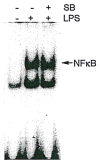Vitamin E suppression of microglial activation is neuroprotective
- PMID: 11592111
- PMCID: PMC3903400
- DOI: 10.1002/jnr.1208
Vitamin E suppression of microglial activation is neuroprotective
Abstract
Neurotoxic microglial-neuronal interactions have been implicated in the pathogenesis of various neurodegenerative diseases such as Alzheimer's disease, and vitamin E has been shown to have direct neuroprotective effects. To determine whether vitamin E also has indirect neuroprotective effects through suppression of microglial activation, we used a microglial-neuronal coculture. Lipopolysaccharide (LPS) treatment of a microglial cell line (N9) induced a time-dependent activation of both p38 mitogen-activated protein kinase (p38 MAPK) and nuclear factor-kappaB (NFkappaB), with consequent increases in interleukin-1alpha (IL-1alpha), tumor necrosis factor-alpha (TNF-alpha), and nitric oxide (NO) production. Differentiated neuronal cells (PC12 cells treated with nerve growth factor) exhibited marked loss of processes and decreased survival when cocultured with LPS-activated microglia. Preincubation of microglia with vitamin E diminished this neurotoxic effect, independently of direct effects of the antioxidant on the neuronal cells. Microglial NO production and the induction of IL-1alpha and TNFalpha expression also were attenuated by vitamin E. Such antiinflammatory effects of vitamin E were correlated with suppression of p38 MAPK and NFkappaB activation and were mimicked by an inhibition of either p38 MAPK (by SB203580) or NFkappaB (by decoy oligonucleotides). These results suggest that, in addition to the beneficial effects of providing direct antioxidant protection to neurons reported by others, vitamin E may provide neuroprotection in vivo through suppression of signaling events necessary for microglial activation.
Published 2001 Wiley-Liss, Inc.
Figures









References
-
- Barger SW, Basile AS. Activation of microglia by secreted amyloid precursor protein evokes release of glutamate by cystine exchange and attenuates synaptic function. J Neurochem. 2001;76:846–854. - PubMed
-
- Barger SW, Harmon AD. Microglial activation by Alzheimer amyloid precursor protein and modulation by apolipoprotein E. Nature. 1997;388:878–881. - PubMed
-
- Behl C. Vitamin E and other antioxidants in neuroprotection. Int J Vitam Nutr Res. 1999;69:213–219. - PubMed
-
- Brenneman DE, Page SW, Schultzberg M, Thomas FS, Zelazowski P, Burnet P, Avidor R, Sternberg EM. A decomposition product of a contaminant implicated in L-tryptophan eosinophilia myalgia syndrome affects spinal cord neuronal cell death and survival through stereospecific, maturation and partly interleukin-1-dependent mechanisms. J Pharmacol Exp Ther. 1993;266:1029–1035. - PubMed
Publication types
MeSH terms
Substances
Grants and funding
LinkOut - more resources
Full Text Sources
Medical

